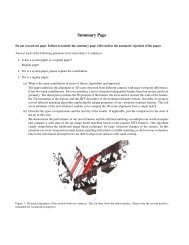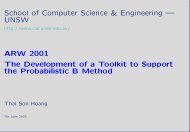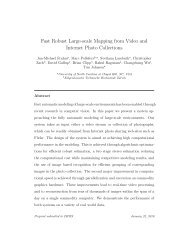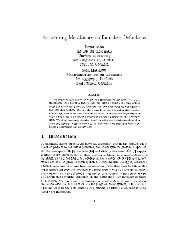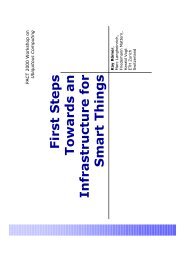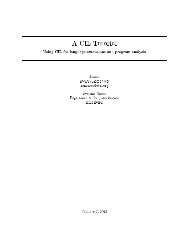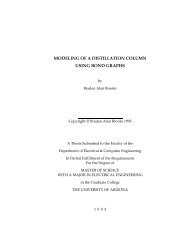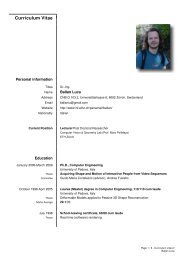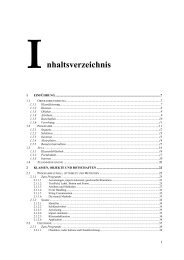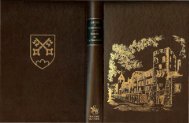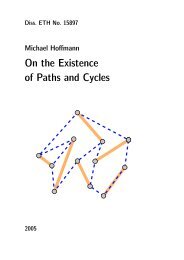PIXHAWK: A Micro Aerial Vehicle Design for Autonomous Flight ...
PIXHAWK: A Micro Aerial Vehicle Design for Autonomous Flight ...
PIXHAWK: A Micro Aerial Vehicle Design for Autonomous Flight ...
You also want an ePaper? Increase the reach of your titles
YUMPU automatically turns print PDFs into web optimized ePapers that Google loves.
Noname manuscript No.<br />
(will be inserted by the editor)<br />
<strong>PIXHAWK</strong>: A <strong>Micro</strong> <strong>Aerial</strong> <strong>Vehicle</strong> <strong>Design</strong> <strong>for</strong><br />
<strong>Autonomous</strong> <strong>Flight</strong> using Onboard Computer Vision<br />
Lorenz Meier · Petri Tanskanen ·<br />
Lionel Heng · Gim Hee Lee · Friedrich<br />
Fraundorfer · Marc Pollefeys<br />
Received: date / Accepted: date<br />
Abstract We describe a novel quadrotor micro air vehicle (MAV) system that<br />
is designed to use computer vision algorithms within the flight control loop.<br />
One main contribution is the integration of a powerful onboard computer which<br />
is a necessity <strong>for</strong> running state-of-the-art computer vision algorithms with<br />
real-time constraints. The system also features IMU-Vision synchronization<br />
by hardware time stamping which allows tight integration of IMU measurements<br />
into the computer vision pipeline. We describe visual pose estimation<br />
from artificial markers and stereo vision integration <strong>for</strong> obstacle detection. The<br />
control architecture is tested in autonomous flights using onboard computed<br />
visual position estimates. In experiments and measurements, we show the benefits<br />
of our IMU-Vision synchronization <strong>for</strong> egomotion estimation, demonstrate<br />
autonomous flight and stereo vision obstacle detection.<br />
Keywords <strong>Micro</strong> <strong>Aerial</strong> <strong>Vehicle</strong>s · Quadrotor · Computer Vision · Stereo<br />
vision<br />
L. Meier · P. Tanskanen · L. Heng · G. H. Lee · F. Fraundorfer · M. Pollefeys<br />
ETH Zurich, CAB G 86.3, Universitaetstr. 6, 8092 Zurich<br />
E-mail: lm@inf.ethz.ch<br />
This work was supported in part by the European Community’s Seventh Framework Programme<br />
(FP7/2007-2013) under grant #231855 (sFly) and by the Swiss National Science<br />
Foundation (SNF) under grant #200021-125017.
2 Lorenz Meier et al.<br />
1 INTRODUCTION<br />
We introduce a novel quadrotor MAV design, the Pixhawk MAV, which is<br />
specifically designed to be a research plat<strong>for</strong>m <strong>for</strong> computer vision based flight<br />
control and autonomous flight using computer vision.<br />
One of our main contributions is the integration of a computing board that<br />
is powerful enough to handle all image processing and flight control processes<br />
onboard on a small scale quadrotor MAV. With the possibility of per<strong>for</strong>ming<br />
all computational processes onboard without the requirement <strong>for</strong> a constant<br />
data link to a ground station, our design brings the vision of having a fully<br />
autonomous quadrotor MAV significantly closer. Another major contribution<br />
is the hardware IMU-camera synchronization of our system. This allows us to<br />
be able to measure the USB image transmission delays in our system precisely.<br />
As a result, we are able to do visual pose estimation with the synchronized<br />
IMU measurements with improved efficiency and robustness. This algorithm<br />
is evaluated and compared to a vision only marker based pose estimation algorithm.<br />
In addition, we further advance the state-of-the-art by integrating<br />
a vision based obstacle detection system onto the MAV system. The stereo<br />
computer vision system produces a high detailed depth map, that gives more<br />
detailed in<strong>for</strong>mation about the obstacle compared to basic sensors as infrared<br />
or sonar. The capabilities of the system are furthermore demonstrated by vision<br />
only autonomous waypoint based flights. The flight accuracy is compared<br />
to Vicon groundtruth.<br />
Finally, all the hardware and software designs are made open-source and<br />
are published on our web page 1 with the goal to create an open research<br />
plat<strong>for</strong>m <strong>for</strong> the community.<br />
Fig. 1 <strong>PIXHAWK</strong> Cheetah Quadrotor<br />
1 www.pixhawk.ethz.ch
Title Suppressed Due to Excessive Length 3<br />
1.1 State-of-the-Art<br />
This paper extends our previous work described in [21]. It extends it by a<br />
more detailed description and evaluation of the system, i.e. the analysis of the<br />
USB image transmission delays. We also add a comparison of a combined IMUvision<br />
pose estimation algorithm to vision only pose estimation. In addition, we<br />
show fully autonomous, onboard computer vision based waypoint navigation<br />
using visual markers and demonstrate the integrated vision based obstacle<br />
avoidance system.<br />
Much of the previous research in autonomous unmanned aerial vehicles<br />
(UAV’s) has been based on quite large UAV’s in the weight range of 10-20kg.<br />
UAV’s of this size are able to carry an extensive sensor suite, e.g. LIDAR,<br />
Radar, camera system and also powerful onboard computers. Impressive results<br />
have been shown in terms of autonomous take-off, landing and navigation<br />
as well as obstacle avoidance [7,28,16,5,29,25,17,14]. To apply these results<br />
to small scale MAV’s of under 1.5kg needs specific adaptations to the algorithms<br />
and sensor hardware. Recent works successfully demonstrated the use of<br />
small LIDAR sensors on such small scale MAV’s <strong>for</strong> mapping and autonomous<br />
flight [13,27,8,30,2,11].<br />
Purely vision based autonomous flight control and mapping <strong>for</strong> small scale<br />
MAV’s did not yet reach the same level of maturity as with LIDAR sensors.<br />
One of the first works in visual MAV control was done by Kemp [18].<br />
He uses an a-priori generated 3D model of the flight area and 2D-3D edge<br />
matching to compute the MAV pose. He demonstrates on-spot hovering of<br />
an MAV. The MAV only carries a small analog camera with wireless image<br />
transmission. All the processing is done off-board.<br />
More recently, Blösch et al. [4] describe visual autonomous flight using<br />
an Asctec Hummingbird and a downward looking camera. A visual SLAM<br />
algorithm is running off-board on a standard PC. The images of the on-board<br />
camera are streamed to the PC using a USB cable connection (the MAV is<br />
actually cable connected, thus limiting the autonomy). Control input is sent<br />
back to the MAV via a radio link. In their paper they demonstrate on-spot<br />
hovering and waypoint following over a 10m trajectory. To ensure enough<br />
visual features <strong>for</strong> SLAM their testbed is covered with textured posters. The<br />
off-board visual SLAM computes positions at varying frame rates between<br />
15-30Hz.<br />
An extension of this work is described by Achtelik et al. [1]. They replace<br />
the Asctec Hummingbird with a bigger model, the Asctec Pelican, and equip<br />
it with an Intel Atom onboard computer. This allows them to run a modified<br />
version of the visual SLAM of [4] on-board with a frame rate of 10Hz. In the<br />
paper, they demonstrate on-spot hovering in an indoor and outdoor setting.<br />
Williams et al. [35] use line and point features <strong>for</strong> visual flight control of<br />
a MAV. They describe three types of flight patterns; traversing, hovering and<br />
ingress. In their experiments, they compute the MAV trajectory offline (from<br />
previously captured images) on a desktop PC <strong>for</strong> the different flight patterns.
4 Lorenz Meier et al.<br />
An approach <strong>for</strong> higher level navigation implemented on a Parrot ARDrone<br />
is described by Bills et al. [3]. The Parrot ARDrone comes with a <strong>for</strong>ward<br />
and downward looking camera and the feature of onboard on-spot hovering.<br />
This makes it an easy to use system. However, the system is closed and has no<br />
payload capability. It is only possible to stream the images of the camera using<br />
Wi-Fi and control it with Wi-Fi. In their work, Bills et al. control the direction<br />
of movement of the MAV from perspective cues they get from images and from<br />
classification of the environment. This allows the MAV to follow corridors and<br />
even make turns. However, there is no notion of a metric map, and the image<br />
processing is completely done off-board on a desktop PC.<br />
The image processing can greatly be simplified with the use of artificial<br />
markers. Artificial markers are used by Eberli et al. [10] <strong>for</strong> hovering, take-off,<br />
and landing. They describe the use of one circular marker to compute the<br />
position and pose of the MAV. In their experiments, the MAV is connected<br />
via USB cable to a ground station, and the image processing is done off-board<br />
on a desktop PC.<br />
A different approach by Li et al. [33] shows hovering, take-off, and landing<br />
of an Asctec Hummingbird equipped with an Intel Atom onboard computer.<br />
They describe the use of an active LED marker pattern. In their approach,<br />
the flight control is done on-board. They demonstrate hovering over a marker<br />
pattern which is mounted on top of a ground robot; the MAV follows this<br />
ground robot.<br />
A similar approach is described by Wenzel et al. [34]. They demonstrate<br />
hovering, take-off, and landing of an Asctec Hummingbird using a marker<br />
plat<strong>for</strong>m mounted on top of a ground robot. The marker pattern is made of<br />
IR LED’s and the MAV’s position is computed from a Wii-mote sensor fitted<br />
to the MAV. The Wii-mote sensor per<strong>for</strong>ms hardware image processing, and<br />
outputs directly the point coordinates of the detected pattern. The final pose<br />
computation is then directly done on the MAV’s low-level controller.<br />
Substantial existing research relies on outside-in-tracking of the MAV (e.g.<br />
by means of a Vicon motion capture system) to measure the vehicle position<br />
[12,22,23,9]. These works mainly focus on low-level control problems or<br />
higher-level tasks assuming given MAV positions and are using off-board control.<br />
The Pixhawk MAV system design itself is an alternative to other commercially<br />
available MAV’s, like Asctec MAV’s 2 , <strong>Micro</strong>Kopter 3 , <strong>Micro</strong>Drones 4<br />
or Parrot ArDrone 5 . The hardware design is quite similar to commercially<br />
available MAV’s. However, while most of the systems have a closed control<br />
architecture, our system is primarily designed as a research plat<strong>for</strong>m, and<br />
there<strong>for</strong>e, has an open control architecture that provides easy access to all the<br />
low level measurements and readily accepts control inputs from higher-level<br />
2 www.asctec.de<br />
3 www.mikrokopter.de<br />
4 www.microdrones.com<br />
5 ardrone.parrot.com
Title Suppressed Due to Excessive Length 5<br />
on-board computers. Together with the software architecture, the ground control<br />
and operator software, and the easy to use marker based localization, the<br />
Pixhawk system is a great testbed <strong>for</strong> MAV research.<br />
1.1.1 Comparison of <strong>PIXHAWK</strong> Quadrotor Plat<strong>for</strong>m (mid 2011)<br />
System <strong>PIXHAWK</strong> Asct. Pelican ARDrone Mikrokopt. Arducopt.<br />
CPU CORE 2 Duo Intel Atom ARM9 ARM9 -<br />
CPU Cores 2 1 1 1 -<br />
CPU MHz. 1.86 GHz 1.2 GHz 468 MHz 90 MHz -<br />
RAM 2 GB 1 GB 128 MB 96 KB -<br />
USB ports 7 7 1 1 -<br />
PCIe ports 0 1 0 0 -<br />
S-ATA ports 1 0 0 0 -<br />
UARTs 4 2 0 2 -<br />
Autopilot ARM7 ARM7 PIC24 ATMega ATMega<br />
AP MHz 60 MHz 60 MHz 24 MHz 16 MHz 16 MHz<br />
AP RAM 32 KB 32 KB 8 KB 96 KB 8 KB<br />
3D Gyro x x x x x<br />
Accelerometer x x x x x<br />
Compass x x - x x<br />
Typ. Max. Weight 1.5 kg 1.5 kg 0.6 kg 1.5 kg 1.5 kg<br />
Typ. Prop. Diam. 10” 10” 7” 10” 10”<br />
Table 1.1.1 shows the difference between different quadrotor plat<strong>for</strong>ms.<br />
While the autopilot capabilities of the <strong>PIXHAWK</strong> quadrotor are similar to<br />
another competitive systems, the onboard computational speed, RAM and<br />
solid-state disk interfaces are unmatched in the MAV domain.<br />
1.1.2 Comparison of MAVCONN middleware<br />
Software MAVCONN LCM ROS<br />
Message <strong>for</strong>mat x - x<br />
Ground Control Station avail. x - -<br />
Radio modem support x - -<br />
Serial comm support x - -<br />
UDP support x x x<br />
UDP Transport Layer LCM LCM ROS<br />
UDP Latency 100-1100 us 100-1100 us 500-1100 us<br />
Stereo triggering x - -<br />
IMU sync x - -<br />
Table 1.1.2 compares different middlewares. As MAVCONN uses internally<br />
LCM as transport layer, all features available in LCM are retained in MAV-<br />
CONN. Our middleware adds a layer on top of LCM, providing the MAVLink<br />
message <strong>for</strong>mat and interfaces to peripherals such as radio modems or USB
6 Lorenz Meier et al.<br />
machine vision cameras. The main difference to ROS is the distributed communication<br />
model without central server and the capability to fully communicate<br />
over radio links when needed. No message rewriting is necessary to communicate<br />
with MAVLink-enabled IMUs or a ground control station.
Title Suppressed Due to Excessive Length 7<br />
2 System <strong>Design</strong><br />
The <strong>PIXHAWK</strong> design includes a powerful onboard computer which makes it<br />
possible to run high-level task, in particular visual localization, onboard the<br />
MAV. The system design is depicted in Fig. 2. Visual localization, obstacle<br />
detection and planning are implemented on the onboard high-level flight computer,<br />
an Intel Core2Duo. The visual localization module computes the full<br />
6DOF pose of the MAV (see details in section 3). The stereo obstacle detection<br />
module computes real-time stereo from the front looking stereo pair (see<br />
section 4). The output of the stereo module can be used <strong>for</strong> obstacle avoidance<br />
by the planning module. The planning module currently implements waypoint<br />
following. Attitude and position controller are implemented on a low-level realtime<br />
controller (see section 5 <strong>for</strong> state estimation). The position controller<br />
takes as input the poses from visual localization and the setpoints generated<br />
from the planner. For MAV control the attitude measurements and the vision<br />
pose estimates need to be synchronized. In our system the synchronization is<br />
solved by hardware triggering the cameras by the IMU and timestamping the<br />
measurements.<br />
Camera<br />
30 Hz<br />
Obstacle<br />
Detection<br />
15 Hz<br />
Planner<br />
Ground<br />
Control<br />
Station<br />
Trigger<br />
Camera<br />
30 Hz<br />
Camera<br />
30 Hz<br />
Visual<br />
Localization<br />
30 Hz<br />
High-Level Linux <strong>Flight</strong> Computer<br />
(Intel Core 2 1.86 GHz)<br />
Position<br />
DKF<br />
50 Hz<br />
Position<br />
Control<br />
50 Hz<br />
IMU<br />
200 Hz<br />
Attitude<br />
Observer<br />
200 Hz<br />
Attitude<br />
Control<br />
200 Hz<br />
Low-Level Realtime Controller<br />
(ARM7)<br />
Fig. 2 The <strong>PIXHAWK</strong> quadrotor system design. The powerful onboard computer enables<br />
high-level tasks as visual localization, obstacle detection and planning run onboard. Position<br />
and attitude estimation are implemented on a low-level realtime controller.<br />
2.1 Vision-IMU Synchronization<br />
Data from different sensors (in particular from multiple digital cameras) is<br />
synchronized by an electronic shutter signal and put together into a timestamped<br />
sensor message. IMU sensor data (e.g. absolute attitude and angular
8 Lorenz Meier et al.<br />
rates) is available as part of the image metadata then. Images are transmitted<br />
over USB to the camera process, while the IMU measurements and the<br />
shutter timestamp are delivered through a serial interface. Image transmission<br />
from camera to main memory via USB takes approximately 16-19 ms<br />
(where the time differs sligthly <strong>for</strong> each image), while the transmission of the<br />
shutter timestamp from IMU to main memory via serial/MAVLink takes approximately<br />
0.1–2 ms. As it is guaranteed that the IMU data arrives earlier<br />
than the image, the camera process can always deliver the full vision-IMU<br />
dataset to the software middleware. Fig. 3 shows the contributions of individual<br />
processing steps to the overall system delay. The transfer time of the<br />
image content from the camera module over USB 2.0 is substantial where fast<br />
localization techniques are concerned.<br />
IMU<br />
trigger<br />
image hub (0.5 ms)<br />
IMU<br />
estimation and control<br />
USB transfer (19 ms)<br />
measured in hardware<br />
5-1000 ms image processing<br />
measured in software<br />
Fig. 3 System delays. Overall delay varies between 25 and >1000 ms. USB and UART<br />
transfer delays are only observable with hardware triggering, else they remain unknown.
Title Suppressed Due to Excessive Length 9<br />
3 Visual Position Estimation<br />
As the <strong>PIXHAWK</strong> middleware provides a precise time base, a standard textbook<br />
estimation and control pipeline was proven to per<strong>for</strong>m well <strong>for</strong> autonomous<br />
flight. Fig. 2 shows the localization and control architecture. Images<br />
are read from the camera at 30 Hz and the position is estimated at the full<br />
camera rate, using additional inertial in<strong>for</strong>mation. The current position is then<br />
used by the onboard mission planner to determine the desired position. The<br />
current and the desired position is fed back to the position estimation and<br />
control software module running on the ARM7 autopilot controller.<br />
3.1 ARTK+ Localization<br />
A localization test bed was created that uses markers with an adapted implementation<br />
of ARToolkit+ [32] <strong>for</strong> the localization. The marker positions are<br />
encoded in a global world map with the 6D position and orientation of each<br />
marker. By extracting the marker quadrangle, the global marker position can<br />
be estimated. The correct orientation on the quadrangle plane and the marker<br />
ID are encoded by a 2D binary code inside each marker. An example of a larger<br />
marker setup is shown in Fig. 4. However, the system itself is not dependent on<br />
this particular approach – any kind of localization algorithm can be used. The<br />
main benefit of using ARToolkit+ in the test bed setup is its relatively low<br />
delay (5-10 ms), its robustness with respect to suboptimal lighting conditions<br />
and the high robustness to motion blur. It is there<strong>for</strong>e very suitable <strong>for</strong> system<br />
testing and validation.<br />
3.2 Vision-IMU fusion<br />
The presence of the inertial measurement unit can be exploited to increase<br />
the robustness and accuracy of the vision-based localization. There are classical<br />
IMU-Vision fusion methods but they all expect some kind of covariance<br />
estimate of the vision position data. This is not possible in a clean way, as vision<br />
based localization typically works on 2D image features that are matched<br />
between two images. Since this matching is not perfect outlier removal is necessary<br />
which again cannot be made error free and the remaining outliers in the<br />
feature correspondences will disturb the position estimate. The covariance resulting<br />
from a non-linear optimization of the vision algorithm cannot correctly<br />
capture these misestimates due to outliers in the feature correspondences. The<br />
more promising method is to include the IMU data directly in to the vision<br />
estimation to be able to use the in<strong>for</strong>mation during the outlier filtering and<br />
position estimation.<br />
If the accuracy of the IMU estimated vertical direction is higher than the<br />
pure vision estimate then it can be included into the vision algorithm to improve<br />
the localization accuracy. Fig 15 shows that the localization accuracy
10 Lorenz Meier et al.<br />
Fig. 4 <strong>Flight</strong> environment with the ARToolkit markerboard on the floor<br />
increases when using two points and the known vertical (from the inertial<br />
data) instead of four points. In case of the 2-point algorithm [19], the calculation<br />
steps <strong>for</strong> the pose estimation are significantly simplified when substituting<br />
parts of the calculation with the IMU roll and pitch (see Fig. 5 <strong>for</strong> the geometric<br />
relation where the image plane is aligned with the surface normal <strong>for</strong>med<br />
by the gravity vector). This speeds up RANSAC which is typically used as<br />
outlier filter <strong>for</strong> image features, so the benefits of directly combining IMU and<br />
vision are, depending on the methods used, improved accuracy and computation<br />
time.<br />
Since the roll and pitch angle of the camera are known through the inertial<br />
measurement unit, the lines connecting the camera center and the 3D<br />
points seen by the camera can be rotated to compensate <strong>for</strong> roll and pitch. The<br />
equation <strong>for</strong> projecting image points into the homogeneous camera space and<br />
rotating the rays is given in equation 1, the same operation is also depicted<br />
in Fig. 5. The pixel coordinate u is projected with the inverse camera matrix<br />
K −1 into the normalized homogenous coordinate space. This ray is then rotated<br />
by roll and pitch with the rotation matrix <strong>for</strong>med by multiplying the<br />
rotation matrices around roll and pitch R φθ . The resulting ray in homogenous<br />
coordinates is now fronto-parallel with respect to the ground plane.<br />
u ′ = R φθ K −1 u (1)<br />
The resulting fronto-parallel view has only x, y and ψ as free parameters.<br />
Kukelova et al. provided a closed-<strong>for</strong>m solution to localize from two points<br />
and known vertical direction by solving <strong>for</strong> x, y, z and ψ. By applying this
Title Suppressed Due to Excessive Length 11<br />
pitch<br />
roll<br />
gravity vector<br />
gravity vector<br />
Fig. 5 Relation of gravity vector and camera angles. The right-fronto parallel view is obtained<br />
by rotating the image plane by the roll and pitch angles.<br />
algorithm in a least squares sense on the ARToolkit correspondences, we obtain<br />
the final position output, since φ and θ were already known. Fig. 15 shows<br />
that the solution of the vision-IMU 2-point algorithm outper<strong>for</strong>ms the 4-point<br />
algorithm used in ARToolkit+ in accuracy. Both algorithms operated on the<br />
same set of visual correspondences based on the ARToolkit+ corners.<br />
In addition, <strong>for</strong> any non-global vision based localization approach, the IMU<br />
in<strong>for</strong>mation can provide the gravity vector and heading as the global reference.<br />
This is especially important <strong>for</strong> loop closure in SLAM where a global attitude<br />
in<strong>for</strong>mation can faciliate loop detection and reduces convergence into local<br />
minimas. This also explains the advantage of storing the absolute attitude as<br />
meta data along the images rather than the relative to the last frame. From<br />
the absolute attitude it is always possible to extract the relative orientation<br />
between any pair of images.<br />
3.3 Outlier Removal<br />
The obtained position vector x, y, z and ψ is filtered with a block 4x1D Kalman<br />
filters in the next step, which implies that the filters are parameterized with<br />
an error model of the computer vision approach. As IMU and vision both<br />
estimate the 3 degree of freedom attitude of the helicopter, this redundant<br />
data can be used to detect and remove position outliers produced by the<br />
localization step. Any erroneous vision measurement will not only contain<br />
a wrong position estimate, but also wrong attitude estimate because of the<br />
projective dependency of position and attitude. Position outliers can there<strong>for</strong>e<br />
be rejected based on the comparison of roll and pitch estimates from the IMU<br />
and from the visual localization. Notice the effect on position outliers when<br />
including the IMU data already into the vision estimation in Fig 15. The<br />
variance on the position is reduced by a significant amount such that there is<br />
no need <strong>for</strong> subsequent outlier removal anymore.
12 Lorenz Meier et al.<br />
4 Stereo Obstacle Detection<br />
The front looking stereo camera allows us to get depth in<strong>for</strong>mation in both<br />
indoor and outdoor environments, and with depth in<strong>for</strong>mation, we can reliably<br />
detect obstacles in the MAV’s vicinity, and compute their locations. In our<br />
stereo processing pipeline, we compute disparity data from stereo image pairs,<br />
and subsequently, compute a point cloud which is used <strong>for</strong> obstacle avoidance.<br />
If there is a cluster of points with a minimum density that is observed to be<br />
within the safety clearance of the MAV, an alert message is published. Any<br />
planning module that receives this alert can either per<strong>for</strong>m an emergency stop<br />
or take evasive maneuvers.<br />
4.1 Point Clouds from Stereo<br />
With each stereo image pair, we rectify both images, and use a block-matching<br />
stereo correspondence algorithm to build a dense 640 x 480 disparity map.<br />
Subsequently, we compute the depth to the points in the scene relative to the<br />
camera coordinate system:<br />
z = bf d<br />
(2)<br />
where d is the disparity. Differentiation of Equation 2 with respect to d<br />
yields:<br />
∆z = bf ∆d (3)<br />
d2 ∆z denotes the resolution of the range measurement corresponding to d.<br />
To avoid spurious range measurements due to small disparities, we set the<br />
minimum disparity:<br />
⌈√ ⌉<br />
bf∆d<br />
d min =<br />
(4)<br />
∆z<br />
In our case, we choose conservative values of ∆z = 0.25 and ∆d = 0.5.<br />
With these values, the maximum range of our stereo camera with a baseline<br />
of 5 cm and a focal length of 645 pixels is 4 m.<br />
We compute the 3D coordinates of each pixel relative to the camera coordinate<br />
system:<br />
⎡<br />
⎣ x ⎤ ⎡<br />
cam<br />
y cam<br />
⎦ = z ⎣ 1 0 −c ⎤ ⎡<br />
x<br />
0 1 −c y<br />
⎦ ⎣ i ⎤<br />
j⎦ (5)<br />
f<br />
z cam 0 0 f 1<br />
where z is the depth associated with the pixel, (c x , c y ) are the coordinates<br />
of the principal point of the camera, f is the focal length, and (i, j) are the
Title Suppressed Due to Excessive Length 13<br />
image coordinates of the pixel. The values of c x , c y , and f, together with the<br />
stereo baseline b are obtained from an one-time calibration.<br />
We then find the world coordinates of each point:<br />
⎡ ⎤<br />
⎡ ⎤<br />
x world<br />
x cam<br />
⎣y world<br />
⎦ = imu<br />
worldH cam<br />
imuH ⎣y cam<br />
⎦ (6)<br />
z world z cam<br />
where imu<br />
worldH is the homogeneous trans<strong>for</strong>m from the world frame to the<br />
IMU frame and is estimated by the visual odometry, and cam<br />
imuH is the homogeneous<br />
trans<strong>for</strong>m from the IMU frame to the camera frame and is estimated<br />
using the InerVis calibration toolbox [20].
14 Lorenz Meier et al.<br />
5 State Estimation and Control<br />
The state estimation is run on the low-level controller to satisfy the realtime<br />
requirements of the system. In addition this allows to compensate visual localization<br />
loss or the loss of the complete onboard computer connection. In<br />
such an event the system per<strong>for</strong>ms an open-loop safety landing maneuver. To<br />
synchronize inertial data and vision estimations, the IMU keeps a buffer of<br />
attitude measurements <strong>for</strong> the last n image frames. Once it receives a vision<br />
position estimate, it reads out the buffered sensor values and per<strong>for</strong>ms a state<br />
estimator update.<br />
5.1 Discrete Kalman Estimation<br />
After the outlier rejection, the remaining positions are more con<strong>for</strong>mant to<br />
the normal distribution, and allow the use of a simple discrete Kalman filter.<br />
As the dynamics of a quadrotor are only loosely coupled in the x, y and z<br />
directions [6], the dynamics can be modeled as three independent dimensions.<br />
As the yaw angle is of much better accuracy and resolution in indoor settings<br />
from computer vision than from a magnetometer (due to iron structures in<br />
the building), the yaw angle is taken as the fourth independent dimension <strong>for</strong><br />
filtering. Given this quadrotor dynamic model, the Kalman filter is designed<br />
as a block of 4 x 1D Kalman filters with position and speed as states. The<br />
Kalman filter assumes a constant speed model, and takes position as input.<br />
The estimated velocity is critical to damp the system, as the only physical<br />
damping is the air resistance on the horizontal plane, which is not significant<br />
at the hovering or low-speed conditions the system is typically operating in.<br />
The states of the four Kalman filters are:<br />
[ [ [ [ ẋ ẏ ż ψ˙ψ]<br />
x k = y<br />
x]<br />
k = z<br />
y]<br />
k = ψ<br />
z]<br />
k =<br />
We estimate the current state of the vehicle x k , which is modeled by<br />
x k = A · x k−1 + w k−1 .<br />
Where the dynamics matrix A models the law of motion, x k−1 is the previous<br />
state and w k−1 the process noise.<br />
A =<br />
[ ]<br />
1 ∆t<br />
0 1<br />
This motion is measured at certain time steps, where the measurements<br />
are expressed as the gain H times the current state plus the measurement<br />
noise v.<br />
z k = H · x k + v k
Title Suppressed Due to Excessive Length 15<br />
The speed in the model will there<strong>for</strong>e only be changed by measurements,<br />
and then again, assumed constant during prediction. From this <strong>for</strong>mulation,<br />
it is already obvious that varying time steps can be handled by the filter as<br />
long as they are precisely measured. As this filter does not include the control<br />
input matrix B, the filter is assuming a constant speed model, which is a valid<br />
approximation if the filter update frequency is fast enough with respect to<br />
the change of speed of the physical object. Because the <strong>PIXHAWK</strong> system<br />
provides a precise timebase, the filter uses the measured inter-frame interval<br />
as time difference input δt. If measurements are rejected as outliers, the filter<br />
only predicts <strong>for</strong> this iteration and compensates in the next update step <strong>for</strong><br />
the then longer time interval. This allows the system to estimate its egomotion<br />
<strong>for</strong> up to about 500 ms and recover from several dropped camera frames.<br />
5.2 Position and Attitude Control<br />
The current and the desired position is fed back to the position estimation<br />
and control software module running on the ARM7 autopilot controller. The<br />
autopilot calculates the desired attitude and controls the attitude using its<br />
onboard inertial sensor suite. The x- and y-positions are controlled with the<br />
angle of attack of the collective thrust vector by setting the desired pitch angle<br />
<strong>for</strong> x and the desired roll angle <strong>for</strong> y. The z-position can be controlled with<br />
the component of the collective thrust collinear to the gravity vector. The yaw<br />
angle finally can be controlled by the difference of rotor drag of the clockwise<br />
(CW) and counter-clockwise (CCW) rotor pairs. As the discrete Kalman filter<br />
contributes a smoothened position and speed estimate with little phase delay,<br />
the controller can be designed as a standard PID controller implemented as<br />
four independent SISO PID controllers <strong>for</strong> x, y, z, and yaw. Attitude control<br />
was implemented following the standard PID based attitude control approach<br />
<strong>for</strong> quadrotors using one PID controller <strong>for</strong> roll, pitch and yaw each. The craft<br />
is actuated by directly mixing the attitude control output onto the four motors.
16 Lorenz Meier et al.<br />
6 <strong>Micro</strong> Air <strong>Vehicle</strong> and Middleware<br />
Off-board processing effectively makes the MAV dependent on the external<br />
processing unit, and severely limits the safety and operation range of the vehicle.<br />
Our system brings the multi-process architecture and onboard processing<br />
capabilities from the 20-100 kg class to vehicles with around 1.2 kg liftoff<br />
weight. In contrast to systems using local stabilization approaches on specialized<br />
microcontroller hardware (Parrot ARDrone), the system is geared towards<br />
global localization and autonomous exploration of unknown environments using<br />
stereo vision. The presented initial results show that with a 30 Hz frame<br />
rate, our system consumes 10 % of the maximum CPU load (5 ms processing<br />
time per frame) <strong>for</strong> autonomous marker based flight and 40-60 % load (20 ms<br />
processing time per frame) <strong>for</strong> stereo-based obstacle avoidance, which leaves<br />
enough capacity <strong>for</strong> future work. Since the onboard computer offers two CPU<br />
cores, onboard parallel localization and mapping is within reach. GPS and, to<br />
a large extent, laser based systems can offer a deterministic processing time<br />
to fuse the sensor data into the localization. Computer vision in contrast has<br />
varying, and in comparison, often longer processing times, depending on the<br />
image content. There<strong>for</strong>e, the estimation and control steps cannot assume a<br />
fixed interval length ∆t and a fixed processing delay ∆p. Instead, they must<br />
use the actual timestamp of all measurements to calculate the correct latency.<br />
Thus, all data in our system is timestamped with a resolution in the order of<br />
microseconds. This data includes images from multiple cameras, the system<br />
attitude, acceleration data, and barometric data.<br />
6.1 Stereo Head<br />
For the stereo head, the middleware supports 2 Point Grey Firefly MV or<br />
MatrixVision Bluefox cameras that capture 640 x 480 or 752 x 480 grayscale<br />
images at up to 60 Hz. The camera interface is open to support additional<br />
camera models. However, since there is no standard <strong>for</strong> trigger-support used<br />
by different camera module manufacturers it is necessary to implement a small<br />
interface class in the middleware <strong>for</strong> every new camera type. The camera pair is<br />
rigidly mounted with a baseline of 5cm on a carbon composite frame as shown<br />
in Figure 6. The hardware trigger provided by the IMU enables synchronous<br />
capture of images from both cameras; this synchronous capture is crucial <strong>for</strong><br />
accurate estimation of stereo disparity.<br />
6.2 Mechanical Structure and <strong>Flight</strong> Time<br />
Our custom mechanical design (Fig. 6) effectively protects the onboard processing<br />
module in case of a system crash, and the fixed mounting of the four<br />
cameras allows inter-camera and camera-IMU calibration. Our system comes<br />
in two sizes, one optimized <strong>for</strong> very small indoor environments, and one standard<br />
size. As the processing board and up to four cameras represent a relatively
Title Suppressed Due to Excessive Length 17<br />
large payload of 400-800g <strong>for</strong> the small diameter of 0.55 m (0.70 m <strong>for</strong> the larger<br />
version) of the quadrotor, the overall system structure has been optimized <strong>for</strong><br />
low weight. It consists of lightweight sandwich material with composite plates<br />
and an inner layer made of Kevlar. Each of the four motors with 8” or 10”<br />
propeller contributes a maximum of 450-600g thrust, enabling the system to<br />
lift a 400g payload at a total system weight of 1.0-1.2 kg, including the battery.<br />
This allows a continuous flight time of 7-9 minutes with 8” propellers and<br />
14 - 16 minutes with 10” propellers. The propulsion consumes 150-180W <strong>for</strong><br />
hovering, while the onboard computer consumes only 27 W peak. There<strong>for</strong>e,<br />
flight time is governed by the weight of the system.<br />
Fig. 6 Quadrotor Overview<br />
6.3 <strong>Flight</strong> and Processing Electronics<br />
The <strong>PIXHAWK</strong> Cheetah quadrotor design was built from scratch <strong>for</strong> onboard<br />
computer vision. With the exception of the commercial-off-the-shelf (COTS)<br />
motor controllers and cameras, all electronics and the mechanical frame are<br />
custom-designed. First, the payload consisting of the pxCOMEx processing<br />
module and up to four machine vision cameras (PointGrey Firefly MV USB<br />
2.0 or MatrixVision Bluefox), was selected. The system design then followed<br />
the requirements of onboard computer vision. The onboard electronics consists<br />
of an inertial measurement unit and autopilot unit, pxIMU, and the onboard<br />
computer vision processing unit, pxCOMEx.
18 Lorenz Meier et al.<br />
Harddisk<br />
S-ATA II<br />
solid-state<br />
S-ATA<br />
Image Processing Unit<br />
Intel Core 2 / i7<br />
1.86- 2.00 GHz, 2-8 GB RAM<br />
pxCOMex Module<br />
Ubuntu Linux<br />
USB<br />
USB Wifi<br />
802.11n Stick<br />
USB<br />
1x-4x Point Grey<br />
FireFly MV<br />
UART + USB<br />
XBee<br />
Radio Modem<br />
Trigger<br />
UART<br />
Autopilot and IMU Module<br />
ARM7<br />
60 MHz<br />
pxIMU Module<br />
I2C<br />
4x Brushless<br />
Motor<br />
Controller<br />
Fig. 7 Onboard sensors and avionics with electronic buses.<br />
6.3.1 Autopilot Unit<br />
The pxIMU inertial measurement unit/autopilot board (Fig. 8, left part) provides<br />
3D linear acceleration (accelerometer, ±6g), 3D angular velocity (±500<br />
deg/s), 3D magnetic field (± milligauss), barometric pressure (130-1030 Hectopascal<br />
(hPa)) and temperature. The onboard MCU <strong>for</strong> sensor readout and<br />
sensor fusion as well as position and attitude control is a 60 MHz ARM7 microcontroller.<br />
It can be flashed via an USB bootloader and stores settings such<br />
as PID parameters in its onboard EEPROM. It provides the required I2C bus<br />
to the motor controllers and additional GPIOs, ADC input and other peripherals.<br />
It is interfaced via UART to the computer vision processing unit, and<br />
it operates at a maximum update rate of 200-500 Hz.<br />
Fig. 8 From left to right: pxIMU Autopilot, pxCOMex image processing module, microETXExpress<br />
Core 2 DUO 1.86 GHz module
Title Suppressed Due to Excessive Length 19<br />
6.3.2 Image Processing Unit<br />
The processing unit is the core piece of the system and consists of a twoboard<br />
stack. The pxCOMEx base board (Fig. 8, middle) provides the USB<br />
and UART peripherals to interface machine vision cameras, communication<br />
equipment and the pxIMU module. It can accept any micro COM express<br />
industry standard module. Currently, a Kontron etxExpress module with Intel<br />
Core 2 DUO 1.86GHz and 2 GB DDR3 RAM is used (Fig. 8, right), but<br />
future upgrade options include Intel i7 CPUs. It has 4x UART, 7x USB 2.0<br />
and 1x S-ATA 2.0 peripheral options. The typical onboard setup consists of<br />
4x PointGrey Firefly MV monochrome, 1x USB 2.0 802.11n WiFi adapter and<br />
1x S-ATA 128 GB SSD with more than 100 MB/s write speed. The pxIMU<br />
unit, the GPS module and the XBee radio modem are connected via UART<br />
to the processing unit. With a weight of 230 g including cooling and only 27<br />
W peak power consumption, the processing unit can be easily lifted by a wide<br />
range of aerial systems, and not limited to the quadrotor presented here.<br />
6.4 <strong>Aerial</strong> Middleware and Message Format<br />
Existing middleware solutions <strong>for</strong> ground robotics include ROS [26], CAR-<br />
MEN [24] and CLARAty [31]. CARMEN and CLARAty have paved the way<br />
<strong>for</strong> standardized robotics toolkits, but their use has declined with the wide<br />
adoption of ROS. Although ROS has been used on MAVs, all of these toolkits<br />
assume an Ethernet network to all connected nodes. However, MAV onboardnetworks<br />
typically include no onboard Ethernet networks, but several devices<br />
connected via serial links and USB. As these toolkits do not scale down to<br />
this link type, every packet has to be transcoded by bridge processes. There<strong>for</strong>e,<br />
we propose a new communication protocol and architecture that can<br />
be transparently used on different hardware links and minimizes the system<br />
complexity.<br />
As shown in Figure 9, the <strong>PIXHAWK</strong> Linux middleware consists of several<br />
layered software components. This architecture allows to use the different<br />
base communication layers (ROS and LCM) and provides a convenient highlevel<br />
programming interface (API) to the image distribution server. MAVLink<br />
messages from the IMU and the ground control station can also be directly<br />
received in any process. We rely on the Lightweight Communication Marshalling<br />
library (LCM) as the base middleware, as it was shown in [15] that<br />
LCM outper<strong>for</strong>ms ROS in low-latency applications. Another benefit is the increased<br />
robustness of the overall software architecture when using LCM, as no<br />
central server exists and our communication over MAVLink is mostly stateless.<br />
This eliminates a single point of failure (the ROS central node), and also<br />
eliminates possible protocol lockups in stateful implementations (as in many<br />
ROS nodes). Our system can however still benefit from ROS software packages,<br />
such as the ROS Kinect interface, by using our ROS-MAVCONN bridge<br />
process that routes between the two software packages.
20 Lorenz Meier et al.<br />
Linux Vision<br />
Process<br />
Linux Control<br />
Process<br />
XBee<br />
Radio (Air)<br />
Memory LCM/ROS LCM/ROS<br />
UART<br />
MAVLink<br />
USB 2.0<br />
Camera<br />
USB<br />
Image Bus<br />
(shared mem.)<br />
MAVLink broadcast<br />
(topic-filtered)<br />
XBee<br />
Radio (Ground)<br />
MAVCONN MIDDLEWARE<br />
UART<br />
WIFI/UDP<br />
UART<br />
pxIMU<br />
Autopilot<br />
QGroundControl<br />
GCS<br />
Fig. 9 MAVCONN Network showing different physical links using the MAVLink protocol.<br />
The mission and control architecture of the presented robotics toolkit is<br />
based on a lightweight protocol called MAVLink, which scales from serial to<br />
UDP links. It serves also as a communication protocol between the flight computer<br />
(pxIMU) and the onboard main computer (pxCOMex/pxOvero). As<br />
MAVLink is used on all communication links including the downlink to the<br />
operator control unit, it is particularly important that this protocol scales<br />
down to very low bandwidth links and allows the use of several links in parallel.<br />
In turn, this parallel use allows several redundant links, which in our<br />
case, are long-range XBee radio modems and 802.11n Wifi (UDP). MAVLink<br />
has a small 8 bytes overhead per packet, allows routing on an inter-system or<br />
intra-system level, and has an inbuilt packet-drop detection. Due to the low<br />
overhead, it is both suitable <strong>for</strong> UDP and UART/radio modem transport layers.<br />
The efficient encoding also allows protocol execution on microcontrollers.<br />
These properties allowed the building of a homogenous communication architecture<br />
across the <strong>PIXHAWK</strong> system. The MAVLink sentences are generated<br />
based on an XML protocol specification file in the MAVLink <strong>for</strong>mat. The code<br />
generator ensures well-<strong>for</strong>med messages and generates C89-compatible C-code<br />
<strong>for</strong> the message packing and unpacking. This allows fast and safe extensions<br />
and changes to the communication protocol and ensures that no implementation<br />
errors will occur <strong>for</strong> new messages. Our current implementation supports<br />
the use of the lightweight communication marshalling library (LCM) and the<br />
Robot Operating System (ROS) as transport layers.<br />
While we use MAVLink to send system states and control commands, we<br />
do rely on a separate shared memory implementation of an image hub. This<br />
component allows sharing of images of all cameras with an arbitrary number<br />
of Linux processes with the least overhead possible.
Title Suppressed Due to Excessive Length 21<br />
6.5 Mission Management<br />
A core part of the autonomous flight is the onboard mission management logic,<br />
which allows the system to autonomously follow a flightplan or to per<strong>for</strong>m<br />
simple tasks, such as sweeping a region of interest. The user can specify these<br />
missions in the open-source QGroundControl operator control unit. It is a<br />
C++ application using the Nokia Qt toolkit. Communication with the MAV<br />
is based on the MAVLink protocol and transported either via UART / radio<br />
modem or via Wifi / UDP. QGroundControl covers the whole operational<br />
spectrum of an autonomous MAV: It can graph and log system data in realtime<br />
and it provides 2D and 3D moving maps <strong>for</strong> the flight operation.<br />
Fig. 10 QGroundControl displaying the current waypoints and trajectory of the system<br />
Fig. 10 shows a typical operator setup: a 3D moving map displaying the<br />
waypoint locations, the safety / home location and the MAV trail (red ellipsoid,<br />
simulated <strong>for</strong> visualization). By interfacing to Google Earth, up-to-date data<br />
and building 3D models are available to QGroundControl. The bottom part of<br />
the window shows the waypoint list. The operator can either edit the waypoint<br />
list or drag the waypoint icons in the 3D interface. The instrument on the<br />
top right displays the MAV list with one system being active. The circular<br />
instrument below shows the controller state (no in<strong>for</strong>mation available, thus
22 Lorenz Meier et al.<br />
crossed out) and nearby obstacles (no close obstacles present). The gauge<br />
instruments can be configured freely by the user to any sensor value received<br />
by the GCS.
Title Suppressed Due to Excessive Length 23<br />
7 Experiments and Results<br />
We conduct experiments to evaluate the image transmission delays in the<br />
MAV system, the visual localization without and with the vision-IMU 2-point<br />
algorithm, and the stereo obstacle detection, and discuss the results.<br />
7.1 Image transmission delays<br />
Computer vision algorithms can exploit synchronized attitude and vision data<br />
to increase accuracy and robustness. Since machine vision cameras have a<br />
delay in the tens of milliseconds range due to USB / Firewire transfer time<br />
and operating system scheduling delays, it is the best solution to synchronize<br />
the camera to the inertial measurement unit with a hardware shutter. Fig.<br />
11 shows the USB transfer delays (red, bottom curve), the USB and shared<br />
memory interface delay (green, middle curve) and the total camera shutter<br />
to control output delay (blue, top). The measurements show that the overall<br />
delay is in the same range as the interval between two captured images (36 ms<br />
<strong>for</strong> the presented localization). This leads to a large phase shift of the control<br />
output, and there<strong>for</strong>e, has to be properly measured and compensated. Besides<br />
the static delay, the plot also shows that the vision algorithm increases the<br />
delay time to between 24 ms and 35 ms; the increase is double its average<br />
processing time of about 5 ms.<br />
40<br />
35<br />
USB Transfer to onboard Computer<br />
USB Transfer incl. shared memory<br />
Trigger to Control output total (incl. ARTK+)<br />
30<br />
Processing time (ms)<br />
25<br />
20<br />
15<br />
10<br />
5<br />
0<br />
0 5 10 15 20 25 30 35 40 45 50<br />
<strong>Flight</strong> time (s)<br />
Fig. 11 Delay of USB and vision processes - note the non-static delay of the overall position<br />
output.
24 Lorenz Meier et al.<br />
7.2 Visual localization<br />
We per<strong>for</strong>m two experiments to determine the localization accuracy of our<br />
ARToolkit+ localization without and with the vision-IMU 2-point algorithm<br />
described in Section 3.2. In our experiments, we use ground truth data from a<br />
Vicon motion tracking system; the ground truth data is provided at a rate of<br />
50 Hz and is very precise with < 1mm error. The objective of the experiments<br />
is two-fold: to quantitatively measure the ARToolkit+ localization error relative<br />
to the Vicon groundtruth, and to examine whether the 2-point algorithm<br />
improves the localization accuracy by using vision-IMU fusion. To be able to<br />
localize the helicopter with the described vision system during the whole flight,<br />
ARToolkit+ markers were laid out on the floor in the flight area as shown in<br />
Fig. 4.<br />
In each experiment, we use our operator control software, QGroundControl,<br />
as shown in Fig. 12 to set relevant parameters <strong>for</strong> MAV software components,<br />
monitor the MAV’s status, send commands to the MAV, and preset waypoints<br />
<strong>for</strong> autonomous flight.<br />
Furthermore, in each experiment, the MAV executes an autonomous flight;<br />
at the beginning and end of the flight, open-loop takeoff and landing are per<strong>for</strong>med<br />
respectively, using in the control loop only the estimated state of the<br />
MAV without any external position or attitude reference. During the flight,<br />
the MAV uses the localization output to follow the preset waypoints.<br />
Fig. 12 QGroundControl view with live image streaming from the helicopter using<br />
MAVLink over UDP. The live view on the left shows the rectified and depth images from<br />
the stereo camera setup.
Title Suppressed Due to Excessive Length 25<br />
7.2.1 Experiment 1 - <strong>Autonomous</strong> waypoint following<br />
In the first experiment, Fig. 13 shows the localization results using the AR-<br />
Toolkit+ localization without the 2-point algorithm. The plot shows a flight<br />
around a rectangular path and two crossings. The solid black line shows the<br />
planned flight path; the vertical line in the top left corner of the figure indicates<br />
takeoff while the vertical line in the bottom left corner indicates landing.<br />
The grey spheres indicate the waypoints; the radius of each sphere equals the<br />
acceptance radius within which the waypoint is marked as reached. The blue<br />
asterisks represent the position estimates computed by the unfiltered visual<br />
localization, and the red crosses represent the Vicon ground truth.<br />
It is observed in Fig. 13 that the ARToolkit+ localization output without<br />
the 2-point algorithm closely follows the Vicon ground truth, but is subject<br />
to frequent large errors. This is because the localization output is computed<br />
purely based on vision, hence making it extremely sensitive to errors from<br />
the extracted image features. A small error in the position of the extracted<br />
image feature would translate into a large error in the localization output, thus<br />
explaining the frequent large errors.<br />
Fig. 13 Trajectory of an autonomous flight using unfiltered ARToolkit+ localization (blue<br />
asterisks) including takeoff and landing plotted together with the Vicon groundtruth (red<br />
crosses) and planned path (solid line and spheres are the planned waypoints).
26 Lorenz Meier et al.<br />
Fig. 14 An example of image features (black circles) extracted from the 4 corners of AR-<br />
ToolKit+ markers.<br />
7.2.2 Experiment 2 - Comparison of IMU-aided localization<br />
The quadrotor autonomously flies a similar trajectory as in Fig. 13. In our<br />
vision-IMU 2-point algorithm, we first compute the 2D image features that<br />
correspond to the 4 corners of each ARTK marker in full view in the image;<br />
example 2D image features are shown as black circles in Fig. 14. We then<br />
establish 2D-3D correspondences through identification of the marker IDs and<br />
retrieval of the 3D coordinates of the identified markers from the ARToolKit+<br />
configuration file. We use the same set of 2D-3D correspondences to compute<br />
the pose estimates <strong>for</strong> the ARToolKit+ localization without and with the 2-<br />
point algorithm.<br />
Fig. 15 shows a comparison of the localization output from the ARToolkit+<br />
localization without and with our 2-point algorithm as shown in red and blue<br />
respectively; the Vicon readings are shown as groundtruth in green. It is observed<br />
from Fig. 15 that the localization output with our 2-point algorithm<br />
is significantly smoother and more accurate than that without the 2-point algorithm;<br />
the 2-point localization output coincides more closely to the Vicon<br />
ground truth and is not subject to large jumps which occur <strong>for</strong> the localization<br />
without the 2-point algorithm. This is due to the additional roll and<br />
pitch in<strong>for</strong>mation from the IMU which helps to reduce the sensitivity of the<br />
localization process to errors arising from the extracted image features.<br />
In both experiments, the helicopter hovered shortly above the landing position<br />
until it reached a steady hovering state, and then landed. It can be<br />
observed that there are significant cross-track errors between the actual and<br />
planned flight paths. As our focus is not on precise path following, our MAV<br />
system is equipped with basic PID position and attitude controllers which are<br />
not optimally tuned. Furthermore, the localization output does not reflect the<br />
actual position of the MAV, and there<strong>for</strong>e, deviations from the planned flight<br />
path are expected.
Title Suppressed Due to Excessive Length 27<br />
1<br />
z/m<br />
0.8<br />
0.6<br />
0.4<br />
0.2<br />
−1<br />
−1.5<br />
−2<br />
−2.5<br />
2<br />
2.5<br />
−3<br />
1.5<br />
y/m<br />
−3.5<br />
−4<br />
−4.5<br />
0.5<br />
1<br />
x/m<br />
Fig. 15 Position estimates from ARToolKit+ localization without (in red) and with (in<br />
blue) the 2-point algorithm. The Vicon groundtruth is shown in green.<br />
7.3 Stereo Obstacle Detection<br />
We carry out an experiment in which the MAV flies autonomously along preset<br />
waypoints. We show a visualization of the stereo processing at one point of<br />
time; figure 16 shows an image from the left camera of the stereo rig, the<br />
resulting 3D point cloud computed from the corresponding stereo frame, and<br />
the same point cloud colored by distance from the MAV. In the latter two<br />
images, the MAV is shown in green.<br />
Fig. 16 Left: Left stereo image. Middle: Colorized point cloud. Right: Same point cloud<br />
colored by distance from the MAV.<br />
The MAV publishes alert messages if it detects obstacles within a safety<br />
clearance of 0.75m. To test this functionality we put obstacles (plant, person,
28 Lorenz Meier et al.<br />
Table 1 Breakdown of computational time <strong>for</strong> on-board stereo processing using 640 x 480<br />
stereo images. (1.86 GHz Intel R○Core TM 2 Duo)<br />
Process<br />
Image rectification<br />
Disparity mapping<br />
Point cloud generation<br />
Total<br />
Average Computational Time<br />
5 ms<br />
29 ms<br />
1 ms<br />
35 ms<br />
cardboard) along one side of the flight path and closer than the pre-set safety<br />
clearance. Figure 17 shows the outcome of the test flight. The flight trajectory<br />
is shown in blue. The locations where the MAV published alert messages are<br />
marked with red circles. These alert messages could be used by a planning<br />
algorithm to change the flight plan.<br />
The breakdown of computational time <strong>for</strong> the stereo processing on-board<br />
the MAV is described in Table 1.<br />
z/m<br />
0.8<br />
0.6<br />
0.4<br />
0.2<br />
0<br />
−1<br />
−1.5<br />
−2<br />
−2.5<br />
y/m<br />
−3<br />
−3.5<br />
−4<br />
0.5<br />
1<br />
1.5<br />
x/m<br />
2<br />
Fig. 17 <strong>Autonomous</strong> test flight with obstacles. Red circles mark the locations where the<br />
MAV published alert messages (when obstacles are detected within the MAV’s safety clearance<br />
of 0.75m). The flight trajectory is in blue.
Title Suppressed Due to Excessive Length 29<br />
8 CONCLUSIONS AND FUTURE WORKS<br />
The <strong>PIXHAWK</strong> system is a flexible and computationally strong research plat<strong>for</strong>m<br />
<strong>for</strong> autonomous micro air vehicles. Especially if a fast onboard computer<br />
is needed this system design is currently unmatched in the class of small scale<br />
MAV’s. The hardware IMU-Vision synchronization and precise timestamping<br />
allows the fusion of IMU and vision in<strong>for</strong>mation without the need to estimate<br />
and take assumptions about the delays. Our results show that fusing vision<br />
and IMU in<strong>for</strong>mation in the proposed way can improve the accuracy of the<br />
camera pose estimation, and thus, the overall flight per<strong>for</strong>mance. Our plat<strong>for</strong>m<br />
provides a basic setup <strong>for</strong> autonomous flight using ARTK+ markers. At the<br />
same time, the system can interface the stereo cameras and provide a depth<br />
map <strong>for</strong> obstacle detection.<br />
Our overall system design proved useful as a research plat<strong>for</strong>m, and is<br />
intensively used in our group and in several other international research labs.<br />
Future work will be to exploit the powerful onboard computer to do computationally<br />
more demanding visual localization with natural features and<br />
autonomous exploration and mapping. Our communication architecture, in<br />
particular the MAVLink protocol, supports MAV-to-MAV communication. We<br />
aslo want to exploit this in the direction of distributed localization and distributed<br />
mapping of swarms of MAVs.<br />
Acknowledgements We would like to thank our students (in alphabetical order) Bastian<br />
Bücheler, Andi Cortinovis, Christian Dobler, Fabian Landau, Laurens Mackay, Tobias<br />
Nägeli, Philippe Petit, Martin Rutschmann, Amirehsan Sarabadani, Christian Schluchter<br />
and Oliver Scheuss <strong>for</strong> their contributions to the current system and the students of the previous<br />
semesters <strong>for</strong> the foundations they provided. Raffaello d’Andrea and Sergei Lupashin<br />
(ETH IDSC) provided constant and valuable feedback.<br />
References<br />
1. Achtelik, M., Achtelik, M., Weiss, S., Siegwart, R.: Onboard imu and monocular vision<br />
based control <strong>for</strong> mavs in unknown in- and outdoor environments. In: Robotics and<br />
Automation (ICRA), 2011 IEEE International Conference on, pp. 3056–3063 (2011)<br />
2. Bachrach, A., de Winter, A., He, R., Hemann, G., Prentice, S., Roy, N.: Range - robust<br />
autonomous navigation in gps-denied environments. In: Robotics and Automation<br />
(ICRA), 2010 IEEE International Conference on, pp. 1096 –1097 (2010). DOI<br />
10.1109/ROBOT.2010.5509990<br />
3. Bills, C., Chen, J., Saxena, A.: <strong>Autonomous</strong> mav flight in indoor environments using<br />
single image perspective cues. In: Robotics and Automation (ICRA), 2011 IEEE International<br />
Conference on, pp. 5776–5783 (2011)<br />
4. Blösch, M., Weiss, S., Scaramuzza, D., Siegwart, R.: Vision based mav navigation in<br />
unknown and unstructured environments. In: Robotics and Automation (ICRA), 2010<br />
IEEE International Conference on, pp. 21 –28 (2010). DOI 10.1109/ROBOT.2010.<br />
5509920<br />
5. Bosch, S., Lacroix, S., Caballero, F.: <strong>Autonomous</strong> detection of safe landing areas <strong>for</strong><br />
an uav from monocular images. In: Intelligent Robots and Systems, 2006 IEEE/RSJ<br />
International Conference on, pp. 5522 –5527 (2006). DOI 10.1109/IROS.2006.282188<br />
6. Bouabdallah, S., Siegwart, R.: Full control of a quadrotor. In: Intelligent Robots and<br />
Systems, 2007. IROS 2007. IEEE/RSJ International Conference on, pp. 153 –158 (2007).<br />
DOI 10.1109/IROS.2007.4399042
30 Lorenz Meier et al.<br />
7. Conte, G., Doherty, P.: An integrated uav navigation system based on aerial<br />
image matching. Proceedings of the IEEE Aerospace Conference (2008).<br />
URL http://citeseerx.ist.psu.edu/viewdoc/download?doi=10.1.1.119.3963&rep=<br />
rep1&type=pdf<br />
8. Dryanovski, I., Morris, W., Xiao, J.: An open-source pose estimation system <strong>for</strong> microair<br />
vehicles. In: Robotics and Automation (ICRA), 2011 IEEE International Conference<br />
on, pp. 4449–4454 (2011)<br />
9. Ducard, G., D’Andrea, R.: <strong>Autonomous</strong> quadrotor flight using a vision system and<br />
accommodating frames misalignment. In: Industrial Embedded Systems, 2009. SIES<br />
’09. IEEE International Symposium on, pp. 261 –264 (2009). DOI 10.1109/SIES.2009.<br />
5196224<br />
10. Eberli, D., Scaramuzza, D., Weiss, S., Siegwart, R.: Vision based position control <strong>for</strong><br />
mavs using one single circular landmark. Journal of Intelligent and Robotic Systems<br />
61(1-4), 495–512 (2011)<br />
11. Fowers, S., Lee, D.J., Tippetts, B., Lillywhite, K., Dennis, A., Archibald, J.: Vision aided<br />
stabilization and the development of a quad-rotor micro uav. International Symposium<br />
on Computational Intelligence in Robotics and Automation, 2007. CIRA 2007. pp. 143<br />
–148 (2007). DOI 10.1109/CIRA.2007.382886<br />
12. Heng, L., Meier, L., Tanskanen, P., Fraundorfer, F., Pollefeys, M.: <strong>Autonomous</strong> obstacle<br />
avoidance and maneuvering on a vision-guided mav using on-board processing. In:<br />
Robotics and Automation (ICRA), 2011 IEEE International Conference on, pp. 2472–<br />
2477 (2011)<br />
13. Hofiann, G., Rajnarqan, D., Waslander, S.: The stan<strong>for</strong>d testbed of autonomous rotorcraft<br />
<strong>for</strong> multi agent control (starmac). Proceedings of Digital Avionics Systems Conference<br />
(DASC04) URL http://ieeexplore.ieee.org/xpls/abs_all.jsp?arnumber=<br />
1390847<br />
14. Hrabar, S., Sukhatme, G.: Vision-based navigation through urban canyons. Journal of<br />
Field Robotics 26(5), 431–452 (2009). DOI 10.1002/rob.20284. URL http://dx.doi.<br />
org/10.1002/rob.20284<br />
15. Huang, A., Olson, E., Moore, D.: LCM: Lightweight Communications and Marshalling.<br />
In: Intelligent Robots and Systems (IROS), 2010 IEEE/RSJ International Conference<br />
on, pp. 4057–4062 (2010)<br />
16. Johnson, A., Montgomery, J., Matthies, L.: Vision guided landing of an autonomous<br />
helicopter in hazardous terrain. In: Robotics and Automation, 2005. ICRA 2005. Proceedings<br />
of the 2005 IEEE International Conference on, pp. 3966 – 3971 (2005). DOI<br />
10.1109/ROBOT.2005.1570727<br />
17. Kanade, T., Amidi, O., Ke, Q.: Real-time and 3d vision <strong>for</strong> autonomous small and micro<br />
air vehicles. In: Decision and Control, 2004. CDC. 43rd IEEE Conference on, vol. 2, pp.<br />
1655 – 1662 Vol.2 (2004). DOI 10.1109/CDC.2004.1430282<br />
18. Kemp, C.: Visual control of a miniature quad-rotor helicopter. Ph.D. thesis, Churchill<br />
College, University of Cambridge (2006)<br />
19. Kukelova, Z., Bujnak, M., Pajdla, T.: Closed-<strong>for</strong>m solutions to minimal absolute pose<br />
problems with known vertical direction. Computer Vision–ACCV 2010 (2011). URL<br />
http://www.springerlink.com/index/M012M78244081306.pdf<br />
20. Lobo, J., Dias, J.: Relative pose calibration between visual and inertial sensors. International<br />
Journal of Robotics Research 26(6), 561–575 (2007)<br />
21. Meier, L., Tanskanen, P., Fraundorfer, F., Pollefeys, M.: Pixhawk: A system <strong>for</strong> autonomous<br />
flight using onboard computer vision. In: Robotics and Automation (ICRA),<br />
2011 IEEE International Conference on, pp. 2992–2997 (2011)
Title Suppressed Due to Excessive Length 31<br />
22. Mellinger, D., Kumar, V.: Minimum snap trajectory generation and control <strong>for</strong> quadrotors.<br />
In: Proceedings of the IEEE International Conference on Robotics and Automation<br />
(ICRA) (2011)<br />
23. Mellinger, D., Shomin, M., Michael, N., Kumar, V.: Cooperative grasping and transport<br />
using multiple quadrotors. In: Proceedings of the International Symposium on<br />
Distributed <strong>Autonomous</strong> Robotic Systems (2010)<br />
24. Montemerlo, M., Roy, N., Thrun, S.: Perspectives on standardization in mobile robot<br />
programming: the carnegie mellon navigation (carmen) toolkit. In: Intelligent Robots<br />
and Systems, 2003. (IROS 2003). Proceedings. 2003 IEEE/RSJ International Conference<br />
on, vol. 3, pp. 2436 – 2441 vol.3 (2003). DOI 10.1109/IROS.2003.1249235<br />
25. Proctor, A.A., Johnson, E.N., Apker, T.B.: Vision-only control and guidance <strong>for</strong> aircraft.<br />
Journal of Field Robotics 23(10), 863–890 (2006). DOI 10.1002/rob.20155. URL http:<br />
//dx.doi.org/10.1002/rob.20155<br />
26. Quigley, M., Gerkey, B., Conley, K., Faust, J., Foote, T., Leibs, J., Berger, E., Wheeler,<br />
R., Ng, A.: Ros: An open-source robot operating system (2009)<br />
27. Roy, N., He, R., Bachrach, A., Achtelik, M.: On the design and use of a micro air vehicle<br />
to track and avoid adversaries. International Journal of Robotics Research (2010). URL<br />
http://ijr.sagepub.com/cgi/content/abstract/29/5/529<br />
28. Saripalli, S., Montgomery, J., Sukhatme, G.: Vision-based autonomous landing of an<br />
unmanned aerial vehicle. In: Robotics and Automation, 2002. Proceedings. ICRA ’02.<br />
IEEE International Conference on, vol. 3, pp. 2799 –2804 (2002). DOI 10.1109/ROBOT.<br />
2002.1013656<br />
29. Scherer, S., Singh, S., Chamberlain, L., Elgersma, M.: Flying fast and low among obstacles:<br />
Methodology and experiments. The International Journal of Robotics Research<br />
27(5), 549–574 (2008). DOI 10.1177/0278364908090949. URL http://ijr.sagepub.<br />
com/content/27/5/549.abstract<br />
30. Shen, S., Michael, N., , Kumar, V.: <strong>Autonomous</strong> multi-floor indoor navigation with a<br />
computationally constrained mav. In: Robotics and Automation (ICRA), 2011 IEEE<br />
International Conference on, pp. 20–25 (2011)<br />
31. Volpe, R., Nesnas, I., Estlin, T., Mutz, D., Petras, R., Das, H.: The claraty architecture<br />
<strong>for</strong> robotic autonomy. In: Aerospace Conference, 2001, IEEE Proceedings., vol. 1, pp.<br />
1/121 –1/132 vol.1 (2001). DOI 10.1109/AERO.2001.931701<br />
32. Wagner, D., Schmalstieg, D.: Artoolkitplus <strong>for</strong> pose tracking on mobile devices. Proceedings<br />
of 12th Computer Vision Winter Workshop (2007). URL http://www.icg.<br />
tu-graz.ac.at/Members/daniel/ARToolKitPlusMobilePoseTracking<br />
33. Wei Li Tianguang Zhang, K.K.: A vision-guided autonomous quadrotor in an air-ground<br />
multi-robot system. In: Robotics and Automation (ICRA), 2011 IEEE International<br />
Conference on, pp. 2980–2985 (2011)<br />
34. Wenzel, K., Masselli, A., Zell, A.: Automatic take off, tracking and landing of a miniature<br />
uav on a moving carrier vehicle. Journal of Intelligent Robotic Systems 61, 221–238<br />
(2011). URL http://dx.doi.org/10.1007/s10846-010-9473-0. 10.1007/s10846-010-<br />
9473-0<br />
35. Williams, B., Hudson, N., Tweddle, B., Brockers, R., Matthies, L.: Feature and pose<br />
constrained visual aided inertial navigation <strong>for</strong> computationally constrained aerial vehicles.<br />
In: Robotics and Automation (ICRA), 2011 IEEE International Conference on,<br />
pp. 431–438 (2011)



